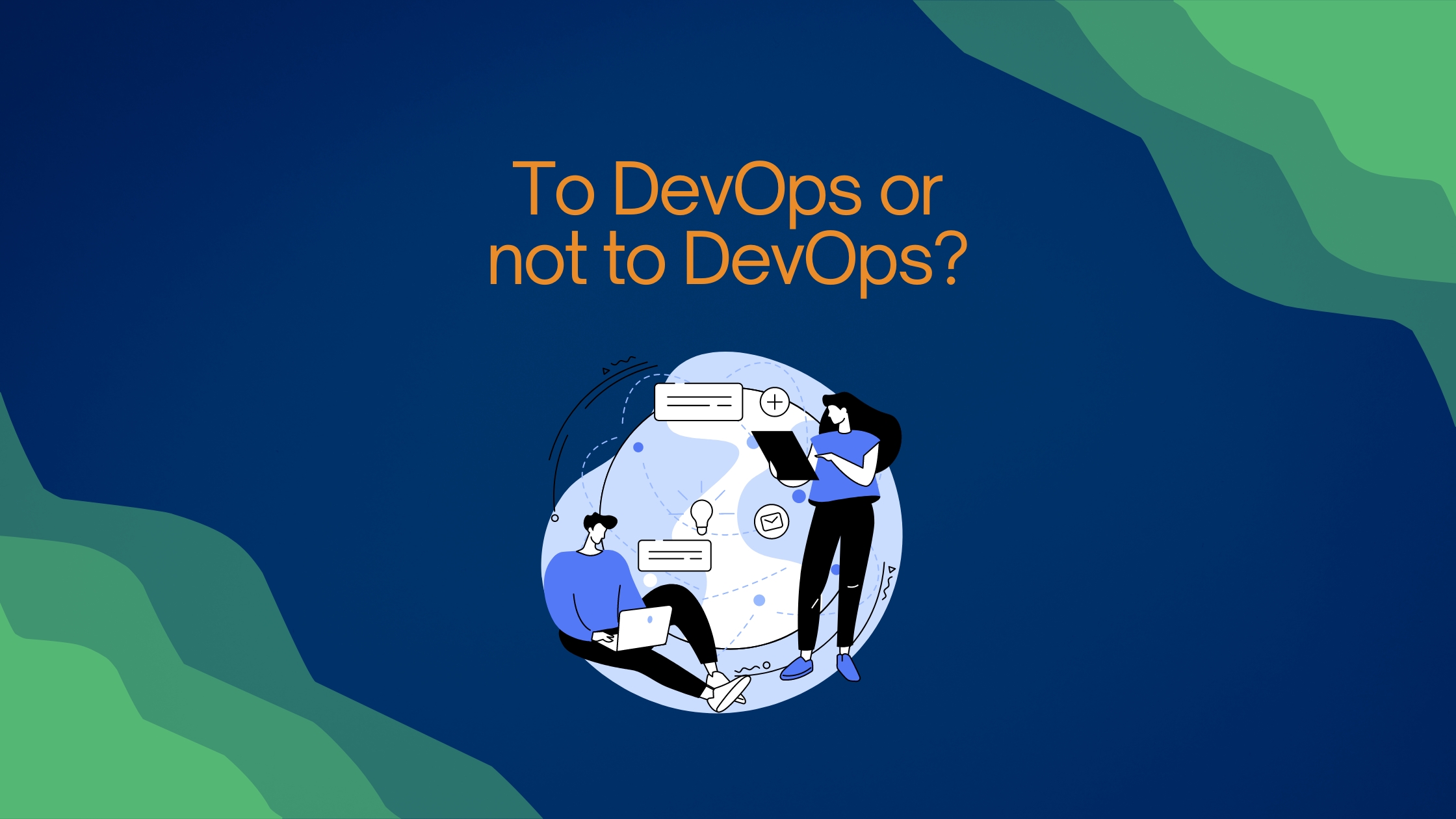Adopting DevOps is not only about replacing the old practices and beliefs, but it also illustrates the choices that an organization takes. The choice that can build the destiny of one business. Even tho, DevOps is one of the most trending topics, with everyone talking about the benefits it can bring, many companies still struggle with answering the question: to DevOps or not to DevOps? In the following article, we will once again describe some of the benefits DevOps holds, but also the challenges it may create.
The Case of DevOps
1. Fast Time to market:
The latest key to competitive advantage in various industries is fast time to market. In our context, this would mean faster release of software, updates and features. Let’s be real, nobody likes a slaggy application or software that buggs all the time, not allowing the customers to do what they initially wanted when deciding to use it. Meeting the demands of the customers in less time could be done by integrating DevOps automation, which decreases the manual work, and the time that tasks need and reduces the failure rate.
For example, consider a software company that has music streaming applications that adopts DevOps practices. By implementing automated testing and deployment pipelines, they can reduce the time it takes to deliver new features from weeks to days or even hours. This accelerated time-to-market allows them to respond fast to customer feedback, stay ahead of competitors, and seize new market opportunities.
2. Better Collaboration and Communication
Traditional software development methodologies often result in siloed teams with limited communication and transparency. DevOps breaks down these barriers, fostering a culture of collaboration, visibility, and shared responsibility. By bringing together development, operations, and other stakeholders, DevOps promotes alignment towards common goals, minimizes misunderstandings, and enhances overall team performance.
For instance, consider a scenario where a software development team encounters a critical issue in production. In a traditional setup, finger-pointing and blame-shifting may ensue between development and operations teams. However, in a DevOps culture, teams collaborate closely to identify and resolve the issue promptly, leveraging tools and practices such as blameless post-mortems and shared dashboards to foster a culture of learning and continuous improvement.
3. Improved Reliability and Stability
While speed is important, it should never come at the expense of reliability. DevOps emphasizes automation, infrastructure as code (IaC), and rigorous testing practices to ensure that software deployments are consistent, repeatable, and error-free. By treating infrastructure as code and automating deployment processes, organizations can minimize downtime, reduce the risk of human error, and improve system reliability.
Consider the case of a major e-commerce platform that experiences frequent outages during high-traffic events, resulting in lost revenue and damage to its brand reputation. By adopting DevOps practices such as automated scaling, fault tolerance, and proactive monitoring, they can significantly enhance the reliability and stability of their platform, ensuring seamless user experiences even during peak demand periods.
4. Scalability and Flexibility
As businesses scale and evolve, they need architectures that can adapt to changing demands quickly and efficiently. DevOps provides the foundation for scalable, flexible systems by leveraging cloud computing, microservices, and containerization technologies. By embracing DevOps principles, organizations can build resilient infrastructures supporting business growth without sacrificing performance or stability.
Consider a start-up that experiences rapid growth in its user base. By leveraging cloud-native technologies and DevOps practices such as infrastructure as code (IaC) and container orchestration, they can scale their application infrastructure seamlessly to handle increasing traffic and workload demands. This agility and flexibility enable them to focus on innovation and business growth without being constrained by infrastructure limitations.
5. Competitive Advantage
Software has become the main engine of innovation and a basis for competition in the digital space today. Companies leveraging the DevOps approach become front-runner having better, safer and higher quality software and thus increase their competitive edge when compared to rivals. These organizations may quickly move to grasp new chances, deliver on customer requirements, and innovate by adopting the DevOps mindset, which will allow them to outpace their rivals and capture market share as well.
Consider the example of two competing mobile banking apps. While both offer similar features and functionality, one embraces DevOps practices to deliver frequent updates, bug fixes, and feature enhancements to its users. As a result, it can adapt quickly to changing customer needs, introduce new services such as mobile payments and biometric authentication, and provide a superior user experience compared to its competitors. This competitive advantage translates into increased customer satisfaction, higher retention rates, and ultimately, greater market share.
The Challenges of Embracing DevOps
Despite its numerous benefits, adopting DevOps is not without its challenges. Cultural resistance, organizational inertia, and legacy systems can present significant hurdles on the path to DevOps transformation. Moreover, the transition to DevOps requires a shift in mindset, as well as investments in training, tooling, and infrastructure. For some organizations, the perceived risks and costs associated with DevOps may outweigh the potential benefits, leading them to hesitate or delay their adoption efforts.
Overcoming Cultural Resistance
The main obstacle in implementing DevOps is overcoming cultural lag with an organization. DevOps requires a paradigm shift, where collaboration, experimentation, and continual improvement become key principles. Nevertheless, many organizations are still operating in the traditional methods of work with various teams functioning in silos, hierarchical structures, and inflexibility to change.
Organizations must foster a culture of trust, openness, and empowerment to overcome cultural resistance. Leaders must lead by example, demonstrating a commitment to collaboration, transparency, and learning. They should encourage teams to experiment, take risks, and learn from failures, rather than punishing or blaming individuals for mistakes. By creating a supportive and inclusive environment, organizations can break down silos, build cross-functional teams, and unleash the full potential of DevOps.
Addressing Organizational Inertia
Another frequent challenge in embracing DevOps lies in tackling the organizational sluggishness and opposition to alteration. Numerous entities are shackled by bureaucratic processes, archaic infrastructures, and outdated technologies, which stifle their capacity for innovation and swift adaptation. Additionally, stakeholders might be hesitant to dedicate time, assets, and effor towards embracing novel procedures or techs, particularly when viewed as troublesome or unnecesary.
To address organizational inertia, organizations must create a compelling vision for DevOps transformation and communicate its benefits clearly and persuasively. Leaders should involve stakeholders early and often in the process, soliciting their input, addressing their concerns, and enlisting their support. They should also ensure resources, training, and support to help teams acquire the skills and knowledge needed to succeed in a DevOps environment. By building a coalition of champions and advocates, organizations can overcome resistance to change and accelerate their journey towards DevOps transformation.
Modernizing Legacy Systems
A major obstacle to DevOps adoption is the presence of legacy systems and infrastructure that are incompatible with modern DevOps practices. Legacy system is an outdated computing software and/or hardware that is still in use. While it continues to fulfill its original purpose, it lacks the capacity for expansion. Its current functionality is fixed, offering no potential for further development within the company. They may be monolithic, tightly coupled, and difficult to change, making it challenging to implement continuous integration, continuous delivery, and other DevOps principles.
Moreover, legacy systems may need more automation, monitoring, and scalability features to support agile, cloud-native architectures.
To modernize legacy systems, organizations must adopt a phased approach that balances risk, cost, and complexity. They should prioritize critical systems and applications for modernization, focusing on areas that offer the greatest business value and potential for improvement. They should also leverage techniques such as:
– strangler patterns: a software development approach used to gradually migrate a legacy system to a new architecture or technology stack. Rather than attempting a complete overhaul all at once, the Strangler Pattern involves incrementally replacing components or functionalities of the old system with new ones. Over time, the new system “strangles” the old one, gradually taking over its functionality until the legacy system is entirely replaced. This approach minimizes risks associated with large-scale migrations and allows for smoother transitions.
– microservices decomposition: the process of breaking down a monolithic application or system into smaller, independent services known as microservices. This decomposition involves identifying cohesive areas of functionality within the existing system and then separating them into individual services that can operate autonomously. Each microservice typically handles a specific business capability or function and communicates with other services via well-defined APIs. Microservice decomposition aims to improve scalability, flexibility, and maintainability by enabling teams to develop, deploy, and scale each service independently. It also facilitates easier integration with other systems and technologies.
– and containerization to break down monolithic applications into smaller, more manageable components.
By modernizing legacy systems incrementally, organizations can reduce technical debt, improve agility, and lay the foundation for successful DevOps adoption.
Why Choose GotoAdmins for DevOps as a Service?
When it comes to DevOps service provider landscape, GotoAdmins distinguish itself as a go-to partner for businesses that need to speed up their DevOps journey. With its wealth of knowledge, expertise, and full commitment to quality GotoAdmins provides a wide range of DevOps services that improve the company’s innovation, efficiency, and overall achievement.
1. Proven Track Record
GotoAdmins boasts a proven track record of success, having helped numerous organizations across various industries achieve their DevOps objectives. With a team of seasoned experts and thought leaders in the field, GotoAdmins brings a wealth of knowledge and experience to every engagement, ensuring that clients receive best-in-class solutions tailored to their specific needs and challenges.
2. Comprehensive DevOps Solutions
GotoAdmins offers a comprehensive suite of DevOps services encompassing all aspects of the software development lifecycle. From initial assessment and strategy development to implementation, automation, and ongoing support, GotoAdmins provides end-to-end solutions that drive tangible business results. Whether clients are looking to optimize their existing DevOps practices or embark on a transformative journey towards DevOps maturity, GotoAdmins has the expertise and capabilities to deliver.
3. Customized Approach
At GotoAdmins, we understand that every organization is unique, with its own set of challenges, goals, and requirements. That’s why we take a customized approach to DevOps, working closely with clients to understand their business objectives, assess their current capabilities, and develop tailored solutions that address their specific needs. Whether clients are operating in highly regulated industries, working with legacy systems, or facing complex technical challenges, GotoAdmins has the flexibility and expertise to adapt and deliver.
4. Cutting-Edge Technologies
GotoAdmins stays at the forefront of technology trends and innovations, leveraging cutting-edge tools, platforms, and methodologies to deliver state-of-the-art DevOps solutions. From cloud-native technologies and containerization to infrastructure as code (IaC), GotoAdmins harnesses the power of the latest technologies to drive efficiency, scalability, and agility for our clients. By staying ahead of the curve, GotoAdmins ensures that clients are well-positioned to capitalize on emerging opportunities and stay ahead of the competition.
5. Dedicated Support and Collaboration
At GotoAdmins, we believe in building long-term partnerships with our clients, based on trust, collaboration, and mutual success. Our team of dedicated experts works closely with clients every step of the way, providing guidance, support, and expertise to ensure the success of their DevOps initiatives. Whether clients need assistance with troubleshooting issues, optimizing performance, or scaling their DevOps practices, GotoAdmins is there to provide proactive support and guidance, helping them achieve their business objectives and drive innovation.
The Bottom Line: Making the Decision
When faced with the question of whether to DevOps or not to DevOps, organizations must carefully weigh the costs and benefits against their unique circumstances and objectives. While the journey to DevOps may involve some initial challenges and investments, the long-term rewards far outweigh the short-term costs. Organizations that embrace DevOps can unlock new levels of efficiency, collaboration, and innovation, enabling them to thrive in today’s fast-paced and competitive market.
In conclusion, the decision to embrace DevOps is not one to be taken lightly. It requires careful consideration, strategic planning, and a commitment to cultural and organizational change. Yet, for organisations seeking to remain competitive in today’s digital economy, the benefits of DevOps are undeniable. By accelerating time-to-market, enhancing collaboration, improving reliability, and gaining a competitive advantage, DevOps-driven organizations can position themselves for long-term success and growth. So, when faced with the question of to DevOps or not to DevOps, the answer is clear: Embrace the change, seize the opportunity, and embark on a journey towards a more agile, resilient, and competitive future.



